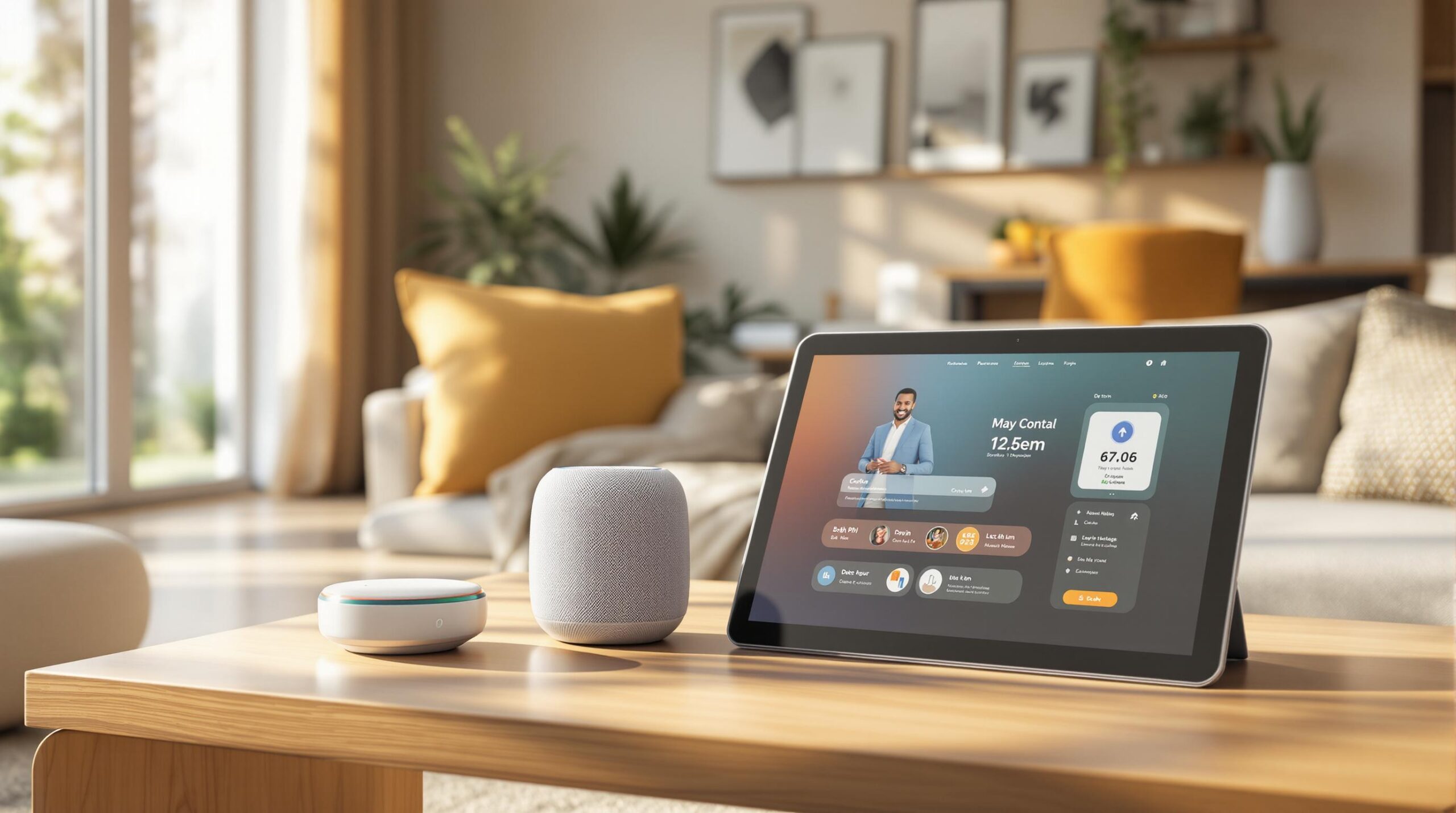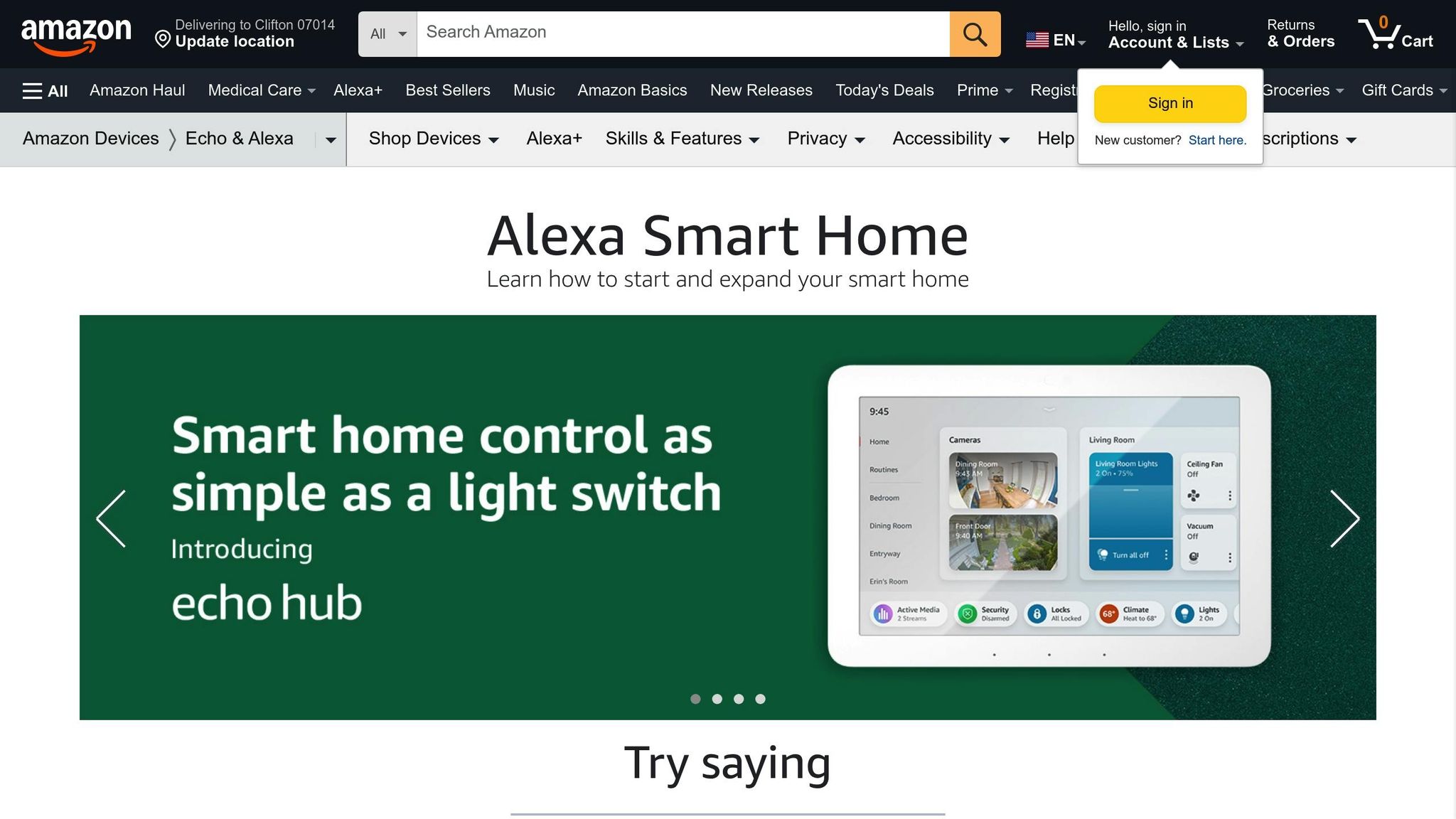
Voice assistants like Alexa are popular, but they fall short when it comes to fully controlling smart devices. Here’s why manufacturers should also invest in custom mobile apps:
- More Control for Users: Apps let users adjust complex settings, manage multiple devices, and set up routines with ease – things that are hard to do with voice commands alone.
- Stronger Brand Identity: Alexa’s system uses its own branding, making it harder for manufacturers to stand out. Custom apps let brands connect directly with users.
- Better Data Security: With Alexa, Amazon controls user data. Custom apps give manufacturers full control over data and privacy.
- No Platform Lock-In: Relying on Alexa means depending on Amazon’s rules and updates. Apps give manufacturers freedom to innovate without restrictions.
Quick Overview: Benefits of Custom Apps
- Improved User Experience: Combine visual and voice controls for better usability.
- Direct Brand Control: Maintain a consistent brand presence and relationship with users.
- Secure Data Management: Protect user data with custom encryption and privacy measures.
- Hardware Integration: Seamlessly connect to device-specific features and updates.
Custom apps are essential for manufacturers to provide better control, security, and brand identity while staying competitive in the growing smart device market.
A Guide to Developing Cross-Platform Mobile Apps for IoT …
Problems with Alexa-Only Control
Voice assistants like Alexa can make life easier, but relying entirely on them for controlling smart devices presents challenges for manufacturers. As the smart device market grows, these issues are becoming harder to ignore. Here’s a closer look:
Limited Device Features
Alexa’s voice-only interface can make certain tasks frustrating. For example, scheduling multiple actions or tweaking settings often requires lengthy voice commands. It also limits how users discover Alexa Skills, leaving many features underutilized. Tasks that work better with visual feedback – like adjusting complex settings – are especially affected, preventing devices from reaching their full potential.
Weak Brand Presence
Nearly half (45.2%) of U.S. mobile users prefer voice interaction, but manufacturers face an uphill battle in maintaining their brand identity. Alexa’s system forces the use of wake words like "Hey Alexa", which overshadows the device maker’s brand. This creates a fragmented experience, making it harder for manufacturers to establish a strong connection with their customers.
Data Security Concerns
Protecting user data is critical, but relying on Alexa as the main interface means manufacturers lose control over vital information. Data related to user behavior, device performance, and customer preferences is managed by Amazon, not the device maker. This raises security and privacy concerns and underscores the need for manufacturers to develop their own mobile apps to retain control.
Platform Lock-in Issues
"And there’s yet further risk. Brands are beholden to MVAs and their always-evolving technical and design constraints for third parties (e.g., screen-optimized voice experiences), as well as their first party product roadmaps, where first-party functionalities (e.g. default music streaming services) could easily usurp third party apps whenever a platform sees fit".
Relying on Alexa means manufacturers face several challenges:
- Costly Updates: Keeping up with platform changes can be expensive.
- Feature Restrictions: Development is limited by Alexa’s boundaries.
- Competition Risks: Amazon’s first-party features can overshadow third-party apps.
- Brand Differentiation: Standing out becomes tough when tied to Alexa’s ecosystem.
Research shows users overwhelmingly favor first-party voice features over third-party ones. This highlights why direct control – through dedicated mobile apps – is crucial for manufacturers looking to stay competitive.
Benefits of Custom Device Apps
Custom apps give manufacturers the tools to regain full control over their devices and data, addressing the limitations of relying solely on Alexa-based control. These apps can significantly enhance the user experience and provide more flexibility.
Better User Control
Custom apps offer users more precise control over their smart devices. With a dedicated app, users can:
- Access complex settings through clear, user-friendly interfaces.
- Control devices remotely instead of depending on proximity to a smart speaker.
- Manage multiple devices at the same time.
- Set up automated routines and schedules with ease.
These advanced interfaces go beyond voice-only commands, offering a more flexible and complete way to manage devices.
Direct Brand Control
For manufacturers, custom apps are a way to:
- Deliver a consistent brand experience.
- Build direct relationships with customers.
- Offer tailored features and recommendations.
- Maintain control over how their products are presented and used.
This ensures brands stay connected with customers while reinforcing their presence in the market.
Hardware Integration
Custom apps work seamlessly with proprietary hardware, allowing manufacturers to:
- Manage device-specific settings.
- Control update cycles and decide which features can be voice-activated.
- Quickly roll out product improvements and updates without relying on third-party platforms.
This level of integration simplifies updates and allows for faster product development.
Data Control
With a dedicated app, manufacturers have direct access to user data, enabling them to:
- Analyze usage patterns and performance metrics.
- Identify areas for improvement.
- Offer features like direct product ordering and consumables management.
This helps manufacturers maintain control over their data while improving service delivery.
Security Management
Security is critical for smart devices, especially those handling sensitive information. Custom apps allow manufacturers to implement robust security measures, such as:
- Custom encryption protocols.
- Regular updates to address security vulnerabilities.
- Two-factor authentication options.
- Monitoring network activity for potential threats.
- Ensuring compliance with industry regulations.
Up next, we’ll dive into the must-have features that make these benefits possible.
sbb-itb-7af2948
Must-Have App Features
Device Dashboard
Research shows that fragmented control can frustrate users, making a centralized dashboard a key feature. A well-designed dashboard should offer:
- Real-time updates on device status
- Quick-access widgets for commonly used functions
- Centralized control for managing lights, plugs, switches, cameras, and thermostats
Additionally, offline functionality and easy device pairing enhance the user experience by keeping everything connected and accessible.
Connected Device Support
To create a unified smart home experience, apps need to integrate seamlessly with other devices. Key features include:
- A pairing assistant with QR code scanning for quick Wi-Fi setup
- Options for device sharing and compatibility across different platforms
Alert System
A good notification system keeps users informed and in control. It should provide:
- Customizable alerts tailored to user preferences
- Notifications through multiple channels like WhatsApp, Slack, or Telegram
Offline Mode
Taking a cue from popular offline features, smart device apps should ensure functionality even without an internet connection. This includes:
- Local control of devices
- Cached settings and preferences for uninterrupted use
- Automatic synchronization of data when reconnected
- Access to essential features during outages
These features highlight how custom apps can provide better control and integration compared to voice-only platforms, offering a more complete and reliable smart home experience.
Steps to Build Your App
Creating an app for smart devices requires a careful balance of functionality, security, and user experience. Here’s why it matters: 88% of users uninstall apps with bugs or glitches. This makes a solid development process absolutely critical.
Choose a Development Team
Partnering with the right development team is step one. Sidekick Interactive, for example, focuses on IoT and connected device applications, with expertise in handling sensitive data and technical challenges. Look for a team skilled in:
- IoT integration
- Strong security measures
- Hardware communication protocols
- Scalable solutions for future growth
Expect costs to vary widely. Basic apps may cost $5,000–$10,000, while more complex IoT apps with advanced features often exceed $50,000. Spending on quality development upfront can save headaches down the road.
Build Core Features First
Start with the essentials – this is often called the Minimum Viable Product (MVP). It helps test core features and gather early feedback from users. Here’s a breakdown of the typical timeline for these stages:
| Phase | Timeline | Focus |
|---|---|---|
| Planning | 2–4 weeks | User flows, wireframes, technical specs |
| Core Development | 8–12 weeks | Basic device control, user authentication |
| Testing | 4–6 weeks | Functionality, security, performance |
| Initial Release | 2 weeks | App store submission and deployment |
Implement Security Standards
Once the core features are in place, focus on security. With 60% of companies reporting mobile app security breaches, this step is non-negotiable. Prioritize:
- End-to-end encryption for device communication
- Secure, modern authentication methods
- Regular security audits
- Compliance with regulations like GDPR and CCPA
Add Advanced Technology
Finally, consider adding advanced features to enhance user experience. Technologies like machine learning, voice recognition, and biometric authentication can take your app to the next level. For example, the mobile AI market, valued at $2.14 billion in 2020, is projected to grow more than four times by 2026.
Spotify is a great example of this in action. They use machine learning to deliver personalized content, which keeps users engaged and coming back.
Conclusion
Moving Beyond Alexa
Alexa’s 160,000+ skills have made strides in voice control, but relying solely on voice assistants limits what manufacturers can achieve. While voice search may be quicker, it falls short when it comes to offering full control over devices. Alexa’s challenges with skill discovery and limited interface options further hinder user adoption.
Why Custom Apps Matter
Custom mobile apps bring clear advantages to smart device manufacturers:
| Benefit | Impact |
|---|---|
| User Experience | 52% of U.S. smartphone users rely on voice assistants. Custom apps provide more intuitive, versatile controls beyond voice. |
| Brand Control | Full ownership of user experience and access to data analytics, boosting engagement and loyalty. |
| Security | Direct control over data protection and compliance ensures sensitive information stays secure. |
| Hardware Integration | Tailored performance through seamless integration with device-specific features. |
A 2022 survey found that 87% of decision-makers prioritize improved productivity, while 77% focus on creating new business opportunities through voice-enabled technologies. Custom apps meet these needs while allowing manufacturers to maintain full control over their brand.
These benefits highlight why custom apps are a smart investment.
What’s Next?
To remain competitive, smart device manufacturers need to embrace custom app development. Our proven track record shows that this strategy delivers measurable results. With 40% of adults using mobile voice search daily, combining voice control with a custom app creates a powerful opportunity.
Ready to take the next step? Contact Sidekick Interactive today to begin developing your custom app. Let us help you enhance your smart device experience with cutting-edge IoT integration and robust data security.


